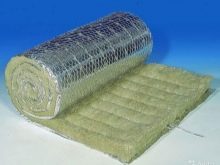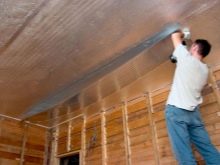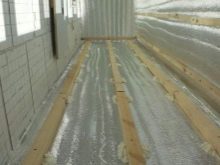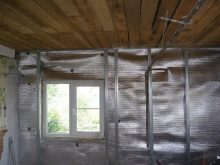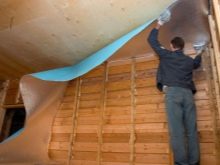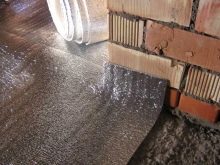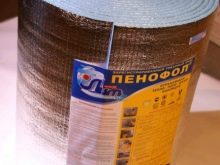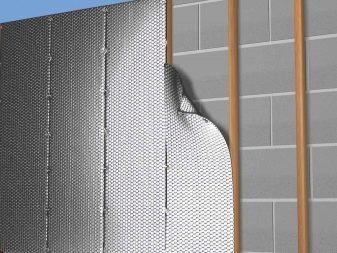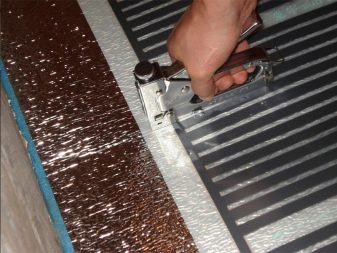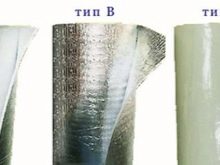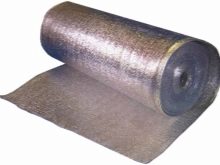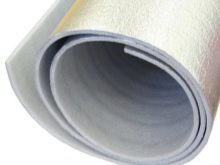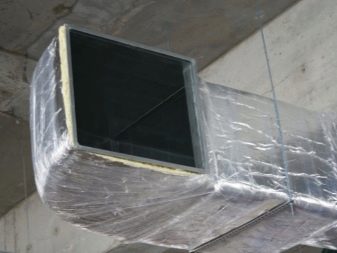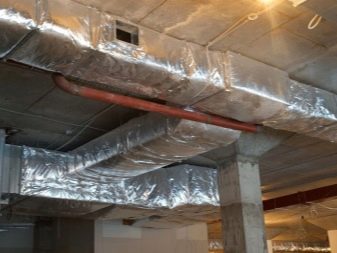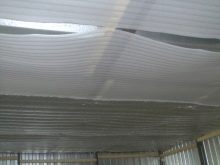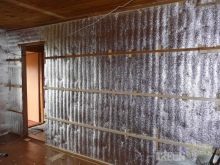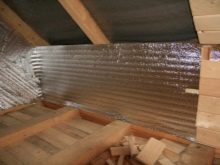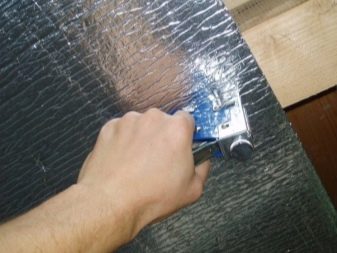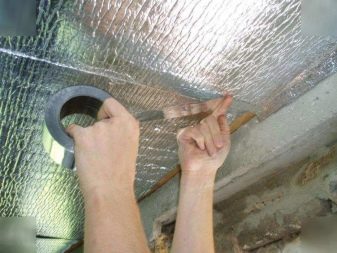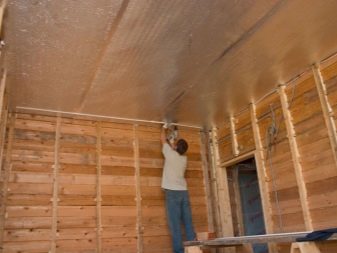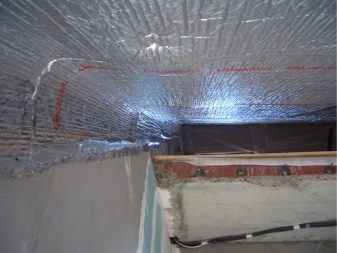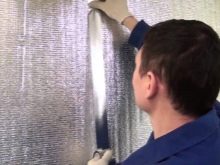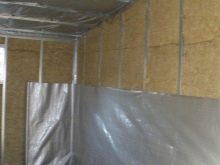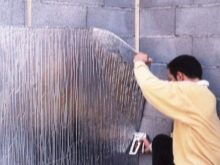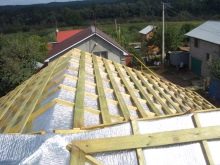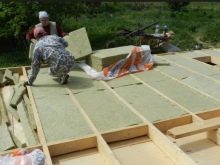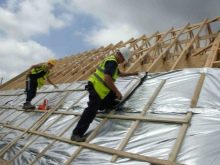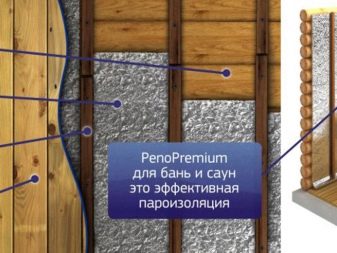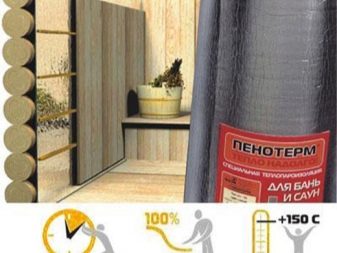Reflective thermal insulation: technical characteristics and scope of application
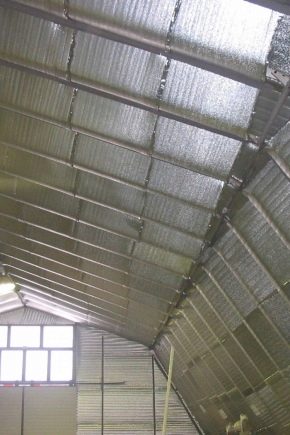
Reflective insulation - a two-layer material consisting of a base and a reflector. As the base is used a variety of thermal insulation, for example, foam cellophane, mineral wool, polystyrene foam. Duralumin layer is applied as a screen. Directly he keeps warm. The sheet functions as a mirror, reflecting more than 85% of thermal radiation, and does not allow it to leave thermal insulation.
Special features
Reflective insulation has the following important technical characteristics:
- temperature range of application - the higher the better;
- thermal conductivity coefficient - from 0.038 to 0511 W / m · ° C;
- insulation thickness;
- coefficient of reflectivity - from 90%;
- vapor permeability - in rare cases exceeds 0.001 mg / m · h · Pa;
- flammability group - G1-G4 (under fire conditions, the first variety is acquired).
Selecting a reflective insulation, it is necessary to use the type of base offered by the manufacturer and take into account its purpose. Thus, to apply type B material inside the building is not only unprofitable from a financial point of view, but even risky: the effect of the bath will be felt already from the first day of operation. For saunas, it is preferable to select brands that have a wide thermal spectrum of use (with a boundary above 90 degrees).
In addition, reflective heat insulation is used for:
- insulation of walls, basements and cellars, ceilings and roofs;
- Improving the thermal resistance of some structures (double-glazed windows, doors);
- protection of special equipment (refrigeration systems, plumbing fixtures, ventilation);
- Heat reflections from radiators.
In addition, it is often used as a packing material for some devices.
There are several key advantages of thermal insulation with a reflective layer.
- The ability to reduce costs: during the insulation does not need to use a large amount of materials. For cozy living conditions in the building and minimizing the cost of heating, you should increase brick walls 55 cm wide. In a wood building, the wall layer will become 35 cm longer. If mineral wool is used in the insulation, then its layer can reach up to 254 cm.
- With the narrowing of the walls, the load on the base of the house is significantly reduced, which makes it possible to reduce its volume. This is a new savings.
- The simplicity of the design of thermal insulation. Its installation is carried out absolutely easily.
- This insulation is harmless and is environmentally friendly. For its manufacture use the same raw materials as for the production of products in contact with food.
- Due to the low weight of the material, it is practical to transport it.
Due to the light cells in polyethylene foam, it has a high thermal conductivity. The heat that has penetrated the building is not able to go outside - it remains inside. Foil material is capable of carrying significant overload.This material is very durable (with proper installation). In addition, it is very easy and comfortable to use. On the wall or ceiling cover it is strengthened with a specially built stapler. There is insulation with bonding. Thermal insulation layer with a reflective layer on the basis of polyethylene can be up to 20 mm.
The main disadvantage of this insulation - softness, because of what it can not be covered with plaster and wallpaper.
For the purpose of fixing, any convenient method is able to be applied. Good reviews for self-adhesive types of fixation. Unlike many vapor barrier films, as well as with reflective elements, foam insulation is located, tight, and not with an overlap. However, this does not mean at all that the seams do not need to be closed up, on the contrary, this stage is considered necessary. The main material for termination is dural special tape.
Today, reflective and heat reflective porilex brand "Mosfol" is in demand.
Kinds
There are 3 types of reflective insulation with markings A, B and C.
- If the title of the heater contains the letter BUT, this means that only one of its surfaces is covered with a reflector.It is used to insulate virtually any surface, and its width may be different. It is placed foil side inside the room.
- Thermal insulation with a letter AT coated on both sides with aluminum foil. Usually it is used for finishing freezers due to the fact that the cold does not come out, and the heat does not penetrate inside. This material is also used to hold different temperatures in rooms.
- Insulation with a letter WITH in the title - this is a reflective insulation with a self-adhesive layer. One of its sides is covered with aluminum foil, and the second - with an adhesive mixture and a protective film. This type of insulation is considered the most convenient for installation.
Principles of use
Reflective insulation can be used only as an additional (auxiliary) means of insulation. For objectivity, it must be said that in certain cases, a reflective TIM can be both the main and even the only means of insulation. For example, when weatherization ventilation systems. But in standard private buildings there is no such need. Because of its features, reflective insulation can be used as a vapor barrier and moisture-proof material indoors.
In the case of using TIM, you need to understand some points and nuances of its application. It is forbidden to use reflective TIM specifically for hydro and vapor insulation works. Reflective TIM should be used as a general insulation (moisture, steam and noise), and if you take into account its environmental friendliness, it has a significant advantage compared to conventional materials when laying, for example, indoors.
When insulating ceilings there are almost no restrictions - you can apply it everywhere.
- For insulation of ceilings, requirements for energy saving are undoubtedly higher than, for example, for walls, and an additional layer does not hurt.
- Inside the room, the warm air always moves upward, that is, the boundary conditions of the floor work are also worse compared to the walls of the room.
With additional wall insulation, a reflective TIM can be used not for all rooms. For example, in the absence of good ventilation, you can get a steam room in which it will simply be impossible to stay. When working with a reflective TIM, it must be taken into account that it only works correctly if there is an air gap and mechanical protection (usually this is done constructivelyby) Because of this, set the TIM on the ceiling or wall, and then paste the wallpaper - it will not work.
How to warm?
Ceilings
At the initial stage, you need to understand how much material is needed and how to fasten it. Considering the area of insulation, add 10 cm on each side and get the right amount of material. It can be easily cut with a knife. When cutting, you need to make a stock (at least 3-4 cm) for the future installation and adjustment of the material on the design and the exclusion of surplus.
The reflective layer of insulation is installed inside the premises. It is necessary to make an overlap on the walls - better with a margin. Any excess can then be easily removed with a knife. If the ceiling is wooden, then laying TIM on the ceiling can be done with a construction stapler. At the same time, it is necessary to immediately set the material correctly in relation to building structures: inaccuracy during installation at 1 cm in the beginning can outgrow at 10 and at 20 cm at the end. The distance between the brackets is set in the course of work. The main condition is the absence of waves on the insulation.
Strips of reflective TIM should be placed end-to-end, and then glued with special (reflective) adhesive tape.
Walls
For maximum efficiency of wall insulation, an air gap of 15–20 mm should be left from the foil surface. Reflective insulation with conventional insulation is effectively used for high-rise and low-rise structures. At the same time, the thermal protection of walls rapidly increases without changing their volume.
Usually when weathe the walls inside the premises, two mounting options are used. In the first variant, two air gaps are left: between the outer wall and the insulation, between the insulation and the facing of the wall, for example, plasterboard sheets. In the second variant, one gap is provided: between the outer wall and the thermal insulation. In this case, the material is used with the marking A. Foil must be turned inside the room.
Roofing
This work is usually done using mineral wool. Let's start with the materials for the roof: waterproofing, which fits under the roof, a heat insulator with a thickness of more than 15 centimeters, a vapor barrier. But it should be noted that the effectiveness of this combination is only 85%.
What can be done? Only thicken the insulating layer. There is only one way: instead of the vapor barrier material, use penofol,the effectiveness of thermal protection which is already 97%.
The best way is to lay the insulation from the inside even at the stage of construction of the roof. That is, after installing the vertical posts, it is necessary to overlap the waterproofing material over them. Then the crate and roofing material is stuffed.
The remaining work is done from the attic or attic room. A heater is laid in the interracial space, over which penofol is packed. After that, you can close it with various finishes (wall paneling, plywood).
How to choose?
When choosing a material for insulation of building structures, it is necessary to take into account some important points.
- First of all - it is temperature range of application. Practically any reflecting TIM will be suitable for most of the premises, both residential and household. For saunas, baths and other rooms with high rates of humidity and temperature, it is desirable to use a material based on polypropylene, which has a wide range of use (up to +150 degrees). From the “price-quality” point of view, in most cases, it is optimal to use a reflective TIM that is 4 mm thick.This is claimed by the manufacturers themselves.
- The reflectivity of TIM depends on the composition. The aluminum foil coating is preferable to the metallized lavsan film not only in reflectance, but also in the temperature range, and in terms of mechanical parameters. However, in some cases, this insulation may have a limitation on the application due to the fact that the aluminum coating is electrically conductive. The quality of reflective TIM depends on their manufacturing technology (cross-linked or unstitched polyethylene). There are physically and chemically crosslinked polyethylene.
In practice, when buying a TIM, you can use this trick: if you look at the bright light through the material, you can clearly see the quality of the material (stripes, uniformity, spots and their number).
Comparing the materials among themselves, you can find the best option for yourself. Sometimes it happens that a rise in price of a material by several rubles can be reimbursed for its better quality.
Reflective insulation greatly reduces the heat loss of the building and this minimizes the cost of its heating and the amount of fuel used.Before you buy the material, you need to see its certificate of quality, as some manufacturers instead of aluminum foil on the surface of the insulation cause a thin layer of metal. Such insulation, based on the feedback from professional builders, has significantly worse characteristics, and its service life is also less. If a roll of insulation has a very low price, then surely it is a fake.
For a review of reflective insulation for PenoHome walls, see the video below.


